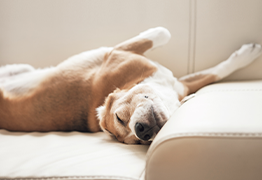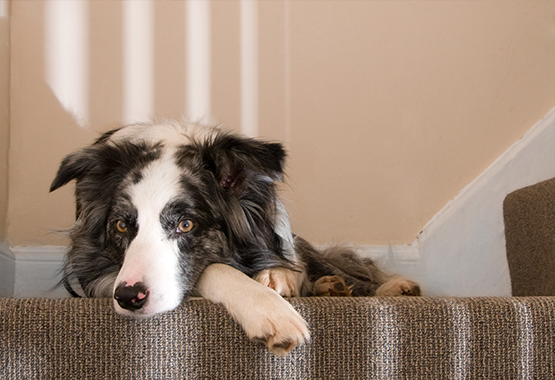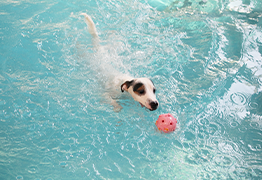7 Signs Your Dog Has Hip Dysplasia
Skeletal disorders can hinder your dog’s lifestyle as they grow older, and as an owner it can be hard to watch your dog decline in any way. If you’re nervous that your dog is exhibitingsigns of hip dysplasia, read on to learn the signs.
What is Canine Hip Dysplasia?
Canine hip dysplasia is among the most common skeletal disorders. Although it is more frequent in larger breed dogs, it can occur in smaller breeds as well. It is a genetic disease that’s commonly influenced by environmental factors such as age and weight gain, and occurs due to an abnormal formation of the hip socket.
The hip joint,which works as a ball and socket, may develop improperly, or not fit together correctly. The joint should be able to slide smoothly, but instead they rub and grind together, causing deterioration, pain, lameness, arthritis, and in some cases, loss of function in the joint.
Signs of Hip Dysplasia in Dogs
How can you tell if your dog has hip dysplasia? The following conditions can be symptoms of this disorder.
Decrease in activity
If you notice a change in their temperament a decrease in activity, hip dysplasia may be the cause. You might notice that your dog is sleeping or resting more often than usual, and may be less enthusiastic about moving around or playing. Be careful to not mistake this decrease in activity as an effect of aging. Hip dysplasia can affect a dog at any age and this symptom should not be ignored.
Physical appearance
When a dog is in pain, they tend to favor other parts of their body, causing changes in their physical appearance. You may see an increase in shoulder muscle mass, but a decrease in thigh muscle mass. This can be the result of your dog trying to favor their front, as to put less pressure on their hips. This muscle mass sensation may result in your dog having a narrower stance.
Noticeable hip and joint pain
If you touch your dog’s hip, they might exhibit discomfort. This can be due in part to two things. As the ball pops out of the socket, tiny fractures could be occurring in the rim of the socket. As dogs age there is a breakdown of cartilage and cushioning tissue that acts as a shock absorber for joints. These factors can be the root to the discomfort. The inflammation caused by these factors could also indicate osteoarthritis.
Swaying gait “bunny hopping”
“Bunny hopping”references the abnormal change in gait sometimes seen in dogs with hip dysplasia. It looks as if the dog is lifting both hind legs simultaneously like a jumping bunny.
Reluctance to climb stairs, jump, and or run
The hind legs significantly help dogs climb stairs, jump, and run. When inflammation develops, this decreases the range of motion in the dog’s joint. You may see your dog hesitate to do these actions or become reliant on assistance.
Trouble getting up
Your dog may have difficulty standing up after laying down. The difficulty to get up is seen most in the morning or after sleeping, but as they move throughout the day, the stiffness may go down. Surfaces also impacts their rising, hardwood flooring is more difficult due to the lack of traction than carpet for instance. If possible have your dog lay on surfaces with a little better traction.
Hind-limb lameness
Over time, the disorder’s effects can lead to bone proliferation, and the joint changes. The inflammation and pain can cause favoring or a hind limb to be non-weightbearing.
How to Manage Hip Dysplasia
Hip dysplasia affects every dog differently and although the disorder is irreversible, there are different approaches to help your dog. Talk to your veterinarian to see what changes are best for you to make for your dog.
Every Day Changes
There are multiple small changes that you can make as an owner to help alleviate the pain your dog experiences. Just as it is for humans, swimming is a gentle exercise alternative for dogs. If possible, have your dog swim. Alongside exercise, try to decrease your dog’s jumping with pet steps and ramps, but note that not all dogs are comfortable using these aids.
Allowing your dog to slowly warm up before exercising can also help with stiffness. You can also break up your dog’s exercise sessions. Ten minutes of exercise three times a day, for example, is gentler than one 30 minute session. If you walk your dog on a leash, consider purchasing a supportive harness.
Within the house there are also changes that can be made. If weight gain is causing the disorder to worsen, consider feeding your dog food that is formulated specially for weight control. Weight reduction can take stress off of their hips. Elevating the food and water bowls will also help to ease pain. Finally, consider purchasing a soft supportive orthopedic dog bed to help with their stiffness and to make sleeping more comfortable.
Surgery
Depending on the severity of the disorder, your veterinarian may recommend surgery. There are four common surgeries that are recommended to treat hip dysplasia. They are triple pelvic osteotomy (TPO), femoral head osteotomy (FHO), dorsal acetabularrim arthroplasty (DARthroplasty), and total hip replacement (THR). Surgery isup to the discretion of your veterinarian. Sit down and talk to them at your next visit to discuss if surgery is a viable option for your dog.
Natural and Homeopathic Remedies
Because pain medication can have potentially additional or unwanted side effects, consider trying other remedies before pain medication. Joint supplements can help with hip dysplasia because the disorder is a form of degenerative arthritis.Homeopathic remedies like Omega 3 fatty acids, antioxidants, and NSAID’s are also options.



